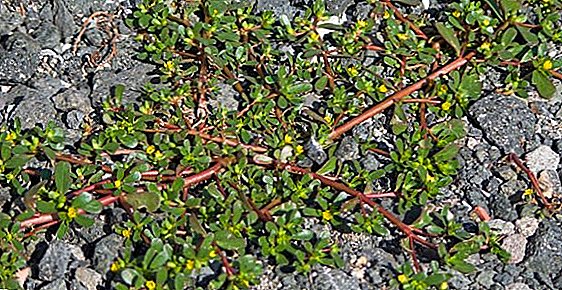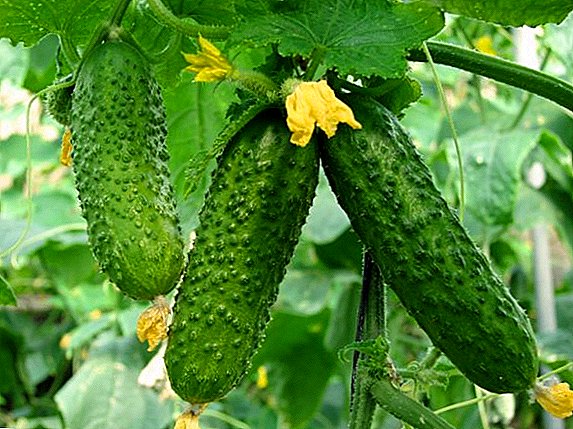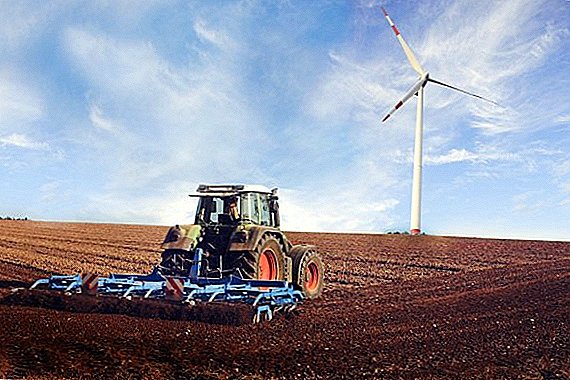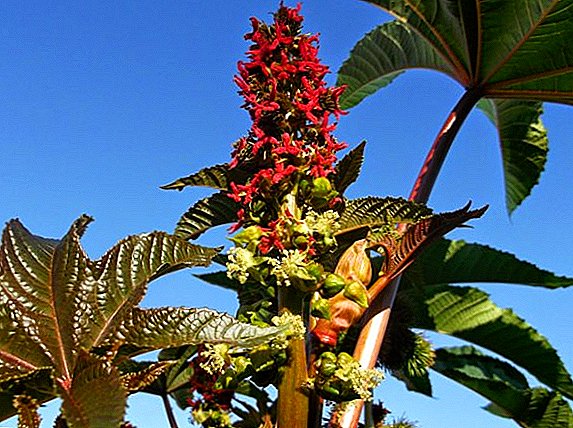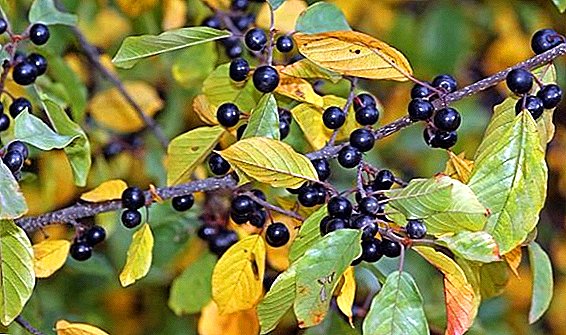 The buckthorn is a tall shrub or small tree that bears inedible fruits, popularly known as wolf berries. The bark of this plant has healing properties and helps with some health problems. The most famous of her actions is the laxative.
The buckthorn is a tall shrub or small tree that bears inedible fruits, popularly known as wolf berries. The bark of this plant has healing properties and helps with some health problems. The most famous of her actions is the laxative.
Read more about the effects of buckthorn-based products on the human body in this article.
Biological description
The Latin name for the buckthorn frangula comes from the word frangere, which means to break. The shrub is so named because it has very fragile branches. The trunk of a plant can reach 5-7 meters in height. It is covered with smooth dark bark.  Buckthorn leaves alternate, with whole or finely serrated edges. The shrub blossoms in May - June with small greenish flowers. They can be pollinated both by insects and independently.
Buckthorn leaves alternate, with whole or finely serrated edges. The shrub blossoms in May - June with small greenish flowers. They can be pollinated both by insects and independently.
After flowering, in September, juicy spherical fruits appear in the form of stones with two to four stones. Initially, they are painted red, and after maturation change color to black. The food berries are not suitable.
Fruits, bark and leaves give resistant dyes. In addition, the buckthorn is used for decorative purposes, for the production of charcoal, plywood, gunpowder, as a melliferous plant.
The bark of two types - fragile (alder) and American (Pursh) - actively used in traditional medicine and cosmetology. It is sold in the form of tubes. In pharmacology, buckthorn is included in the composition of the Reminil, Vikalin, Musinum, Vikair tablets, Kholagol drops, liquid and dry extracts, and gastric fees.
In folk medicine, many poisonous plants are widely used - wolfberry, buttercups, ruta, berry yew, dodder, autumn crocus, bathing vessel, burning bush, comfrey, chickpea hollow, milkweed, cocklebur, hogweed, red elder, dabbers, belladonna grassland, cocklebur, honeycomb, red elder, dabber miller, belladonna grass, cocktail eye flaxseed.
Chemical composition
Buckthorn bark contains frangularazide, which causes a gag reflex in humans, as well as anthranols. As it is stored, frangularazide oxidizes and converts to glycofrangulin.
It is precisely because of this that it is advised to use raw materials for therapeutic purposes only after it has lain a year after collection or after heat treatment with a temperature of +100 ° C for one hour.
It is then that frangularoside, glycofrangulin, frangulaemodine, chrysophanic acid, which are involved in the processing and production of food, will be present in it.
Also in the bark are available:
- alkaloids (up to 0.15%);
- tannins (up to 10.4%);
- Sahara;
- Apple acid;
- essential oil.

Anthraquinones, with which buckthorn is brittle, are rich in laxative and coloring, and are also found in yucca, horse horse, northern bedstraw, sable tree stone, visible aloe tree.
Spread
In the wild, buckthorn is found in the temperate zone of Eurasia, North America, in North Africa, in mixed forests, near rivers. Its neighbors are most often alder, bird cherry, mountain ash, willow, bushes. The genus of the same name has about 40 species. In our latitudes, only one grows - buckthorn brittle.
Medicinal properties
Buckthorn bark has a number of medicinal properties, including:
- laxative;
- antiviral;
- anti-inflammatory;
- antitumor;
- antispasmodic;
- diaphoretic;
- diuretic;
- anti-invasive.
Did you know? One of the first references to the laxative property of buckthorn can be found in the writings of the nature researcher and Italian physician Petrus Crescenius, dated 1305. Also botanist Pietro Andrea Mattioli (1554) writes about this laxative remedy in his works.

Use in traditional medicine
Most often preparations from the trunk cover buckthorn used to eliminate constipation. Their action begins in the large intestine, slowing down the absorption. As a result, the amount of feces increases, and they are pushed out by the intestines. In addition, funds based on buckthorn provoke the dilution of feces, which also facilitates its removal. Usually when using a therapeutic agent, bowel movement occurs after 8-10 hours.
Learn about the properties of oak bark, aspen, viburnum, elm.Means can be used for a long time, with hemorrhoids, ulcers and gastritis. Gynecologists advise women to use them in the presence of such a delicate problem after the birth of a child.
The laxative properties of the plant are also good for those who are overweight and want to lose a few pounds. With their help, you can clean the body well. And in combination with protein diets, you can expect a quick effect.
By the way, buckthorn can be found among the ingredients of many slimming teas. An excellent drink for burning fat is herbal decoction of buckthorn bark, mint, parsley leaves, and fennel. 
Important! Since substances entering the buckthorn bark can cause irritation of the gastrointestinal mucosa, it is necessary to strictly adhere to the dosages prescribed in pharmaceutical preparations and traditional medicine recipes.Buckthorn bark is also used externally. - for the treatment of furunculosis, strepto-and pyoderma, other serious diseases of the skin.
Diuretic properties of buckthorn used to eliminate edema, dropsy, elimination of salts and stones from the kidneys and gall.
Use in cosmetology
Shrub-based products are able to relieve acne, remove inflammation on the face, contribute to the speedy regeneration of the skin, slow down the aging process, give the skin a healthy look.
In addition, the bark can tint hair. This natural color will give your hair a shade from red-brown to dark golden. Broth for hair color is prepared from 100 g of dried crushed bark, which is placed in 2.5 cups of boiling water and boiled for 25 minutes. Broth should be applied to the hair for half an hour. Then wash it off.
Dark chestnut color can be achieved if the broth buckthorn add to henna. Hue will become more saturated as the use of the broth for some time.
Besides the fact that the buckthorn will give color to the hair, it will also make them stronger and healthy looking, shiny and silky.
Collection and storage
The collection of bark should be carried out in early spring. It is better to separate it from young trees that are knocked over in the sap extension phase before they have leaves. The barrel should be cut obliquely at least 10 cm from the soil surface That is how the shrub can quickly recover.
Felled branches and trunks must be cleaned of moss and lichen. Then it is necessary to make circular cuts at a distance of 10-15 cm and connect them with longitudinal cuts. So the bark will be removed without any problems with a straw or groove.
Important! Do not scrub the bark with a knife, because in this case it will be unnecessary remnants of wood.To dry raw materials should be in the open or under a canopy. It is placed in a thin layer on a horizontal surface so that the tubules or grooves do not connect with each other. Periodically, the raw materials are stirred to dry evenly.
The bark is considered completely dried and ready as a raw material for therapeutic agents when it breaks with a bang. If she only bends, then she should be dried.
After the raw material is dried, it is sorted out, removing the blackened pieces and those that have wood residues.
Store dried bark should be pressed in a closed container. Storage space should be cool, dry and well ventilated. The shelf life of dried and properly preserved bark is five years.
Video: how to harvest buckthorn bark
Harm, side effects and contraindications
Prolonged use of products based on this plant leads to addiction, which further provokes the problem of bowel movements. If the dosage is not followed and the dose is exceeded, abdominal pain, strong watery stools may occur. With uncontrolled long-term use may develop glycocalymia.
Buckthorn bark can not be used by everyone, it is contraindicated in:
- pregnancy, because it can increase the tone of the uterus;
- breastfeeding, as it penetrates into breast milk and leads to diarrhea in the baby;
- severe liver and kidney disease;
- heavy menstruation;
- empyema of the gallbladder;
- uterine bleeding;
- children under three years old;
- Gastrointestinal cancers.
Did you know? One type of buckthorn - Pursha - has long been used for medical purposes by Indian tribes living in California and Mexico. They used a decoction of bark to eliminate inflammation, fever with malaria, and also as a cleansing agent for diseases of the gastrointestinal tract and liver.

How to make a decoction
The broth is prepared from dry crushed bark (one large spoon) and boiling water (200 ml). Mixture put on the stove and tormented in a water bath for half an hour. Cool and filter. Bring boiled water to the original volume. For the laxative effect, they drink 0.5 glass before bedtime (children over 12 years old - by quarter glass). Emptying in this case should occur after waking up. The duration of treatment is determined by the doctor.
Preparation of tincture
Dried and chopped bark (one big spoon) is placed in 0.5 l of alcohol (30-40%). Insist for 10 days in a place with a cool temperature, where sunlight does not penetrate. Used for external use as applications.
Infusion: Recipe
The infusion is made from dried crushed bark (10 g) and two glasses of boiling water. Means infused for 8-10 hours. Drink a large spoon before bedtime.
Thus, buckthorn is a plant whose bark is widely used for relieving constipation, cleansing the body, treating problems with the digestive tract, giving beauty to hair. For medicinal purposes, homemade decoctions, tinctures, infusions, as well as pharmaceutical preparations based on buckthorn bark are used. When using these tools, it is important to observe the dosage and familiarize yourself with contraindications.
Video: useful properties of buckthorn, its differences from bird cherry
Reviews of buckthorn
Cleaning with hayhow to effectively clean the intestines and at the same time get rid of a few kg of different nasty things, clogging our organisms.
I heard this recipe from a pediatrician, who is also an energy biologist, helping people to cure various ailments.
It will take: 200 g of white raisins, 200 g of senna, 250 g of holosas (this is an extract from the hips, sold in pharmacies). On the steam bath for 20 minutes insist raisins, filling it with a liter of boiling water. Also cook hay. Then 30 minutes just insist, filter and pour into a 2-liter jar. There also add holosas. The missing amount of liquid up to 2 liters bring boiled water
This broth must be taken at night 100 g for 20 days. It helps very effectively with intestinal obstruction. You will be surprised how much filth accumulates in our body! This cleaning can be done 1 time in half a year.
Shoe with buckthorn
This version of the composition:
1. 100 grams of buckthorn bark (in a pharmacy, this is one pack) + 6 glasses of hot water = 30 minutes boil over low heat, cool, strain
2. 1 cup of raisins + 1 cup of boiling water = 30 minutes stew, strain
3. decoction of buckthorn bark + decoction of raisins + 250ml holosas (holosas is rosehip extract) = mixes, add boiled water up to 1.5 liters. All that happened - in the fridge!
Now, how to drink: the minimum dose of 1/4 cup, the maximum - 1/3 cup 1 time per day, at the same time, at night 1.5 liters will be enough for about 2 weeks, the time of drinking should be chosen, given that the reaction (an urgent date with a white friend) will occur in 6-8 hours
cleaning can be done no more than 4 times a year
deer
//www.fitforum.ru/showpost.php?s=2e9b538bfc62076e9f66ca9d6f9baf4e&p=82434&postcount=3
Before you start to read the body (cholosas, prunes, raisins, hay, buckthorn) Think whether you need it ... I am 14 days. Cleaned for the appointment of her dietitian. This is not a harmless compote !! Carries from 4 - 5 in the morning so ... Znobit, colitis. Everything ended only at lunch ... and it's okay, but 2 weeks have passed, and I have all the most unpleasant symptoms of cystitis Now I need to get tested and go to the doctors ... True weight goes fast enough .Tatyana
//www.woman.ru/health/medley7/thread/4080230/1/#m39509010
About allergies - there was a lot of analysis ... I have food ... And about the toilet it’s like when, when every day, when every 4 days (but the chair is good), I ruined myself, I have no mania for not going to the toilet for the most part in public places, so at first I put up with the house, right now I’ve stopped being shyAnd I tried to lose weight and for this I cleaned the intestines, drank 1 tbsp of broth (1/3 of buckthorn bark, 1/3 of wormwood and something else, I don’t remember already) decoction for the night, and so 10 days, this is on the transfer of Malakhov, then they got sick of their forum and it turned out that it was necessary not 10 days, but 1 wacko.gif I went to the toilet during these 10 days - every day and 1 time each.
And what surprised me - all my allergies were gone! Those allergies from toxins that are flushed into the intestines, really want to expel them.
And so earlier, Maman talked with the doctor, it is necessary to drink from a dysbacteriosis after intestinal cleansing, to restore Frol
Crash
//www.cosmo.ru/forumn/topic/130072- cleansing of the intestine/?do=findComment&comment=19974406


